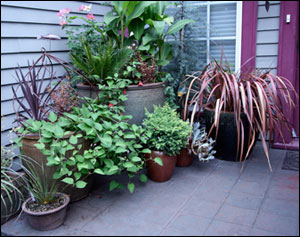Container Gardening

If you have a small area or don’t have the capacity to grow a large garden, consider container gardening. Gardening in containers can be just as rewarding as having a full-size garden. Many plants grow in pots just as well as they do in the ground.
There are a few things to consider when planning for a successful container garden. The first is the plants. If you are planting more than one plant in the same pot, which many do for an attractive and interesting container garden, be sure that all your plants meet the same requirements.
Requirements to consider are amount of light, amount of water, and fertilizer scheduling. Also be sure that the size of the container matches the size of your plant. Some other things you might consider when planning your container garden are height, color, and texture. Variations of these elements will make your container gardens more attractive and very interesting to look at.
Bold and Beautiful Container Gardens
You can provide eye candy to your landscape with bold, beautiful containers that showcase plants with attractive flowers and foliage. Use the guideline “thrillers, spillers, and fillers” when choosing plants. With “thrillers,” don’t be afraid to go wild with color. Incorporate bright flowering plants or the large, colorful foliage of plants like coleus or crotons. Ornamental grasses can also work well. “Spillers” are plants that fall gracefully over the sides of the containers, and for fillers, consider plants with rounded forms or interesting textures. Select containers to complement the plants, and keep in mind how the containers will be viewed.
Caring for Your Container Garden
When watering your container gardens, the best time to do so is in the morning. Watering in the morning allows your leaves and soil to dry out, preventing diseases and viruses. You should water your plant accordingly. You should check to see if your plants need watering before adding more. Overwatering is the most common reason for container plants dying. If you push your finger into the soil, this should give you an idea of how moist or dry the soil is. Do not water a plant if the soil is already moist.
When it comes to fertilizing your container gardens, fertilize only as needed. Over-fertilization will result in a buildup of salts and will burn the roots of your plants. Fertilize your plants during the growing season, and only if needed during the dormant seasons.
The most important thing is to be creative with your container gardens. Try a variety of plants in one container garden. Painting designs on the containers is a fun project, especially with children.
Don’t limit your container gardens to flowers—many vegetables can be grown in a container and actually do quite well. There really is no limit to what can be done in a container!
